As a school-based occupational therapist, I am often approached by teachers that are concerned about students that have awkward or inefficient pencil grasps. It is important to try to modify the pencil grasp early in a child’s school career because it will be harder as they get older to break poor habits.
The most efficient way to hold a pencil is the dynamic tripod grasp where the pencil is positioned between the thumb and index finger with the pencil resting on the middle finger. Another functional grasp is the quadropod grasp where four fingers stabilize the writing implement and the pinky is curled in towards the palm. In both of these grasps, there should also be an open web space (thumb and index finger form a circle) that allows for small movements in the child’s hand.
While a dynamic tripod grasp is optimal, there are many other grasp patterns that are commonly seen in children and it does not always require intervention or modification. If the child is writing neatly with appropriate speed and pressure, but does not have that perfect tripod grasp, then my advice: If it ain’t broke, don’t fix it! You can certainly try the tools below but do not force a change if it is not needed.
Please keep in mind that there are many, many activities to promote a proper tripod grasp. I have just narrowed it down to five of my personal favorites that have often proved effective and that children seem to really enjoy. These tools are all easy to implement at home or in the classroom.
1. Toys With Tongs
Toys with tongs and tweezers encourage the use of the thumb, index and middle finger while working the tiny muscles in that nook between the thumb and index.
- Patch Bed Bugs
- Operation
- Wok n’ Roll
- Hungry Monkey Motor Skills Game (add a dice to this game to further work on in-hand manipulation skills)
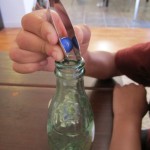 Make it at home: Use strawberry pickers to pick up marbles and place into a narrow mouthed bottle or place each marble on the suction cups of upside down bathtub treads.
Make it at home: Use strawberry pickers to pick up marbles and place into a narrow mouthed bottle or place each marble on the suction cups of upside down bathtub treads.
2. Vertical Surfaces
Working on a vertical surface builds strength and stability in the arms and shoulders. It also places the wrist in a good position for writing.
- Easels
- Chalkboards
- Dry erase boards
- Paper taped to the wall slightly above shoulder height
3. Keeping It Small!
Smaller writing implements naturally encourage a proper grasp.
- Golf pencils
- Breaking crayons and chalk pieces into halves
- Crayon Rocks
- Flip Crayons by Handwriting Without Tears
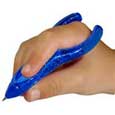
I really like the Twist n’ Write Pencil, as it is small and sets the fingers up really nicely making for an easy transition to a standard pencil.
4. Pencil Grips
Pencil grips are a nice way to teach a child’s hands a new motor plan on how to set up their fingers to control their pencil better.
Two of my favorites are The CLAW & the Grotto Grip
Try the CLAW when four or five fingers are rested on the pencil shaft, as this pencil grip will only allow the tripod fingers to hold the pencil. Sometimes children place all their fingers on the pencil because they have a hard time dissociating the pinky (ulnar) side from the thumb (radial) side of the hand. A great strategy to train their muscles is simply having them hold a marble or small object in their ring and pinky fingers against the palm while holding the pencil with their three free fingers…TA DA, we have a tripod!!!
Try the Grotto Grip when the pencil is held in a tripod grasp but with the thumb wrapped tightly over the index finger OR tucked under, both limit more efficient movements of the thumb and tend to fatigue the muscles in the forearm.
5. Bubble Wrap!
Yes, so simple but so effective. I like the large bubbles for this activity. Have child pop the bubble using their tripod fingers.
Just a few strategies to help facilitate a proper pencil grasp from my good ‘ole Bag of OT Tricks!
– Sari Ockner, OTR/L
Most toys and related items can be found for purchase in my Amazon.com store by clicking on each of the highlighted links above or see the whole store by clicking here. Like Kidz Occupational Therapy on Facebook Follow on Twitter @Sari_KidzOT
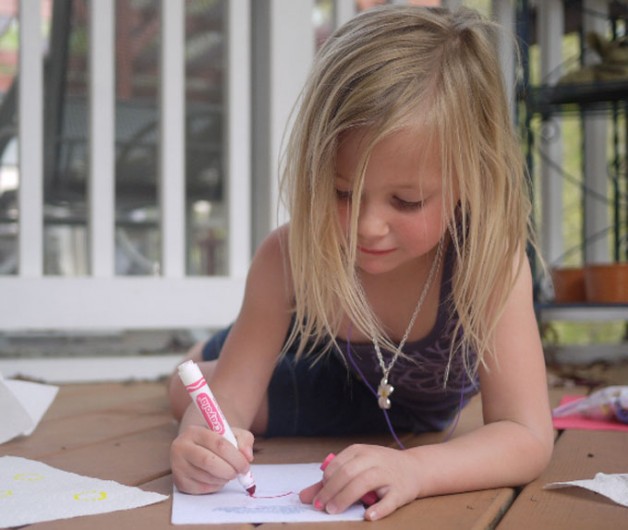
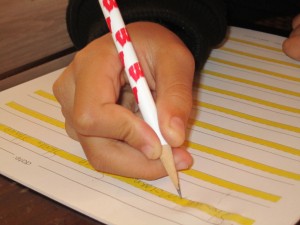
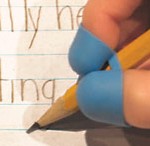
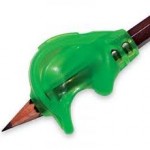



Leave a Reply